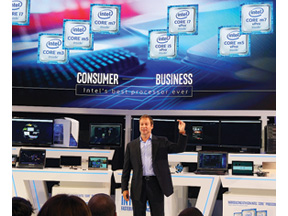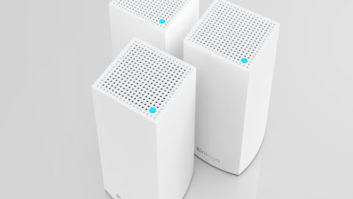
Intel opened up the 2015 IFA here with a self-congratulatory keynote filled with a geek’s wet dream of new computing advancements and starring the company’s sixth-generation core processors.
Admittedly, some strutting is appropriate. Formerly referred to as Skylark, Intel’s new Core M, Iris and Xeon processors offer a series of wondrous and heretofore unavailable PC power and conveniences to Ma and Pa PC Owner and hardcore gamers.
Here are a half dozen takeaways from Intel’s self-administered back-slapping:
1. PCs are better now than they were five years ago. You’d think that concept would elicit giggles from a roomful of know-it-all tech journalists – but it didn’t. Yet Intel senior VP Kirk Skaugen repeatedly compared the company’s new Core M chips to processors from 2010. To Intel’s delight, the new Core Ms deliver 150 percent better performance, 20 times graphics improvement, and three times better battery life than portable PCs dating from the mid-term elections of the first Obama Administration. I know – I’m shocked, too.
2. 12K video is a thing. Intel’s sixth-gen core processors enable not only smooth 4K video editing but, with 30 percent overclocking, the chip can fuel 4K games designed to be played really widescreen – across three side-by-side-by-side 4K monitors, or 12K video. Intel demo’d an impressive hyper-realistic 12K Formula One racing simulation used by actual professional drivers.
3. Look, ma! No password! Now your face can actually be your ticket, thanks to Intel’s True Key app. Instead of having to remember more than two dozen passwords, True Key, powered by Intel’s new processors, remembers your face to instantly provide access. Intel demo’d True Key with a pair of seemingly identical twins who obviously weren’t identical since the True Key PC stayed locked for one twin but instantly unlocked when it saw the other.
4. One cable to rule them all. Lenovo’s P50-15ISK and P70-17ISK workstations look to be the first in what promises to be many PCs fitted with Thunderbolt 3 jacks. Thunderbolt 3 is aptly named – it performs functions that previously required three cables: data transfer (USB-C at speeds up to 40 Gbps, four times the data and twice the video bandwidth of any other cable); display connectivity; and power.
5. Look, ma! No wires (or Qi)! Intel wants to establish a standardized wireless charging future using the magnetic resonance non-specific placement wireless charging solution from the newly combined Alliance for Wireless Power (A4WP) and Power Matter Alliance (Powermat). Instead of separate charging pads, Intel intends to enable multi-device, through-the-table charging, as thick as 50mm of material, of up to 20 watts. And you’ll be able to charge any device via a sleeve or future devices – Intel says some will come this time next year – with wireless charging built-in. Intel already is working with multiple auto makers, airlines and hotel chains to make ubiquitous wireless charging a reality.
6. If you plug it in, it computes. If it computes, it needs to be connected. This is an excellent definition of the Internet of Things, and Intel envisions its button-sized low-power Curie processor will provide the computing for the expected 50 billion IoT devices.












